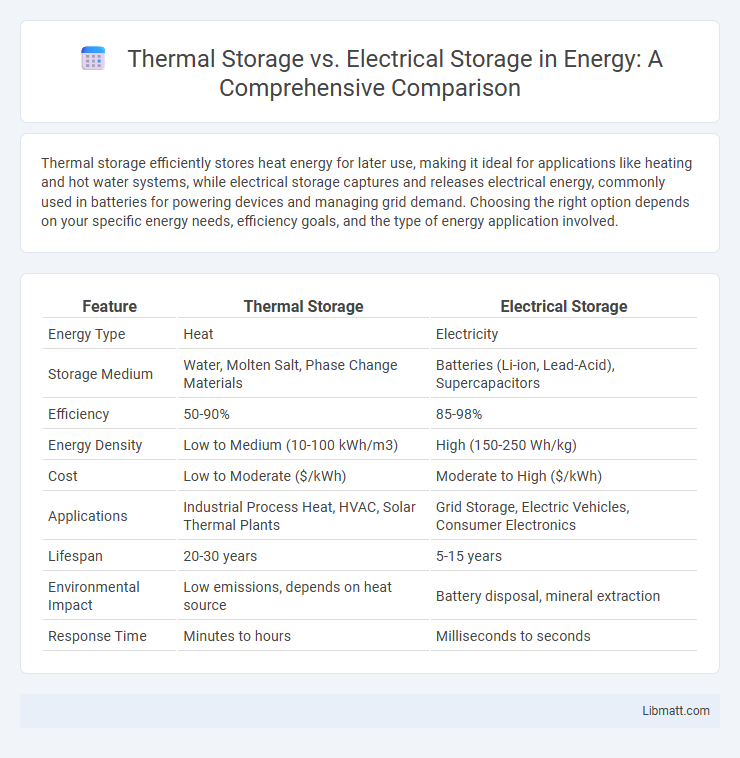Thermal storage efficiently stores heat energy for later use, making it ideal for applications like heating and hot water systems, while electrical storage captures and releases electrical energy, commonly used in batteries for powering devices and managing grid demand. Choosing the right option depends on your specific energy needs, efficiency goals, and the type of energy application involved.
Table of Comparison
| Feature | Thermal Storage | Electrical Storage |
|---|---|---|
| Energy Type | Heat | Electricity |
| Storage Medium | Water, Molten Salt, Phase Change Materials | Batteries (Li-ion, Lead-Acid), Supercapacitors |
| Efficiency | 50-90% | 85-98% |
| Energy Density | Low to Medium (10-100 kWh/m3) | High (150-250 Wh/kg) |
| Cost | Low to Moderate ($/kWh) | Moderate to High ($/kWh) |
| Applications | Industrial Process Heat, HVAC, Solar Thermal Plants | Grid Storage, Electric Vehicles, Consumer Electronics |
| Lifespan | 20-30 years | 5-15 years |
| Environmental Impact | Low emissions, depends on heat source | Battery disposal, mineral extraction |
| Response Time | Minutes to hours | Milliseconds to seconds |
Introduction to Thermal and Electrical Storage
Thermal storage systems store energy by heating or cooling a medium such as water, molten salt, or phase-change materials, enabling efficient management of thermal energy for later use in heating, cooling, or power generation. Electrical storage refers to technologies like batteries and supercapacitors that store electrical energy chemically or physically, allowing for rapid discharge and grid stabilization. Comparing thermal and electrical storage highlights differences in energy density, efficiency, and application suitability across renewable energy integration and demand response scenarios.
Key Principles of Energy Storage Technologies
Thermal storage relies on capturing and retaining heat energy in materials such as molten salts or phase change materials, enabling efficient energy release when needed. Electrical storage technologies, including lithium-ion batteries and supercapacitors, store energy in chemical or electrostatic forms for rapid discharge and scalability. Understanding the thermodynamic properties and charge-discharge cycles is crucial for optimizing performance in both thermal and electrical storage systems.
Types of Thermal Storage Systems
Thermal storage systems include sensible heat storage, latent heat storage, and thermochemical storage, each varying in energy density and application. Sensible heat storage uses materials like water or molten salts to store energy through temperature changes, whereas latent heat storage relies on phase change materials (PCMs) to absorb or release heat during state transitions. Thermochemical storage involves reversible chemical reactions, enabling longer-duration and higher-density thermal energy storage compared to conventional methods.
Types of Electrical Storage Systems
Electrical storage systems include batteries, supercapacitors, and flywheels, each offering distinct energy storage mechanisms and efficiencies. Lithium-ion batteries dominate due to their high energy density and cycle life, while flow batteries provide scalability for large-scale applications. Supercapacitors excel in rapid charge-discharge cycles, and flywheels offer mechanical energy storage with low maintenance and high power output.
Efficiency Comparison: Thermal vs Electrical Storage
Thermal storage systems typically achieve round-trip efficiencies ranging from 70% to 90%, depending on the technology, while electrical storage systems like lithium-ion batteries often reach efficiencies of 85% to 95%. Thermal storage is highly efficient for large-scale energy applications such as concentrated solar power plants, where heat retention materials like molten salts minimize energy losses over extended periods. Electrical storage excels in rapid charge-discharge cycles and grid stabilization due to its higher energy density and efficiency but suffers efficiency drops under extreme temperature variations.
Cost Analysis of Storage Solutions
Thermal storage systems often present lower upfront costs compared to electrical storage, benefiting from simpler materials and established technology like insulated water tanks or phase-change materials. Electrical storage, particularly lithium-ion batteries, exhibits higher capital expenditure but offers greater energy density and efficiency, impacting long-term operational costs and scalability. Evaluating Levelized Cost of Storage (LCOS) reveals thermal options excel in applications prioritizing cost-effectiveness over rapid discharge, whereas electrical storage suits scenarios demanding flexible and high-power delivery despite higher investment.
Applications and Use Cases
Thermal storage excels in applications such as district heating, industrial process heat, and concentrated solar power plants due to its ability to store energy as heat for long durations with minimal losses. Electrical storage, including lithium-ion batteries and pumped hydro, is preferred for grid stabilization, renewable energy integration, and electric vehicle support because of its high efficiency and rapid response times. Thermal systems are ideal for large-scale, steady energy supply, while electrical systems suit dynamic, short-term energy needs.
Environmental Impacts and Sustainability
Thermal storage systems generally have a lower environmental impact compared to electrical storage due to their use of abundant materials and longer lifecycle with minimal chemical degradation. Electrical storage, especially lithium-ion batteries, poses sustainability challenges related to resource extraction, toxic waste management, and energy-intensive manufacturing processes. You can enhance sustainability by leveraging thermal storage solutions that efficiently store surplus renewable energy with reduced ecological footprint.
Technological Challenges and Future Trends
Thermal storage faces challenges in efficiency loss during heat transfer and material degradation under high temperatures, limiting long-term viability, while electrical storage contends with energy density constraints and electrode stability impacting battery lifespan. Advances in phase change materials and thermochemical storage aim to enhance thermal energy retention, whereas solid-state batteries and silicon anodes promise significant improvements in electrical energy storage. Future trends emphasize hybrid systems integrating both storage types to optimize grid stability, renewable integration, and sustainable energy management.
Choosing the Right Storage: Factors to Consider
Choosing the right storage system depends on factors such as energy capacity, duration of storage, and application type. Thermal storage excels in applications requiring medium to long-duration energy retention and cost-effective scalability, while electrical storage offers faster response times and higher efficiency for short-term energy demands. Consideration of system integration, maintenance costs, and specific energy needs ensures optimal selection between thermal and electrical storage solutions.
Thermal storage vs Electrical storage Infographic

 libmatt.com
libmatt.com